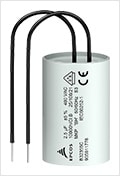source: TDK news
TDK Corporation presents the new B32355C* series of EPCOS MotorCap™ motor run capacitors, which are designed for a high continuous operating temperature of 100 °C. They are based on a metalized polypropylene film, feature self-healing properties, and conform to Safety Class S3 as specified in IEC 60252-1.
These robust capacitors have a rated voltage of 400 V AC at 50/60 Hz. The series consists of six different types with capacitance values ranging from 1.5 µF to 5 µF. The components have been approved by the VDE and their design is IEC 60335-1 compatible (safety of household and similar electrical appliances).
A special design feature of the B32355C* series are the compact dimensions: the capacitors have a diameter of 25 mm and a height of 51 mm to 75 mm, depending on the capacitance. The capacitor can is made of flame-retardant plastic and filled with a dry resin. The terminals consist of two 100 mm cables. At maximum operating voltage the capacitors offer a life expectancy of at least 10,000 h.
Due to its high temperature resistance, this capacitor is particularly suitable for the motors of heating system pumps as well as other AC applications.
Main applications
- Motors of heating system pumps
- AC applications
Main features and benefits
- High permissible continuous operating temperature of 100 °C
- Safety Class S3 according to IEC 60252-1
- Compact design






























